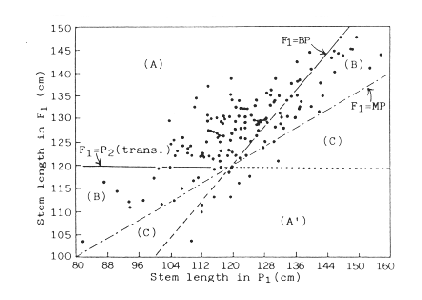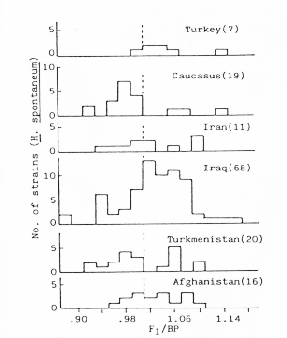

A total of 153 strains of H. spontaneum (P1) which were collected from the areas including Turkey, Caucasus, Iran, Iraq, Turkmenistan and Afghanistan, were crossed with a strain of H. spontaneum, or H. sp. v. transcapsicum (P2). Another series of crosses were made between a six-rowed Pakistani cultivar, C.100-3, as a common parent and 77 out of 153 strains of H. spontaneum. All the F1's, together with their parents, were grown in the field, and their heading times and stem lengths were investigated.
As no correlation was found between stem length and heading time among the F1 plants and also among their parents, correction for stem length based on heading time was not made in this experiment. Fig. 1 shows the relations between stem length of the F1 plants and those of their P1 plants in wild × wild crosses. This clearly indicates, with only a few exceptions, strong dominance of the F1 plants as to the stem length. More than 65% of the F1's (A in the Fig. 1) manifest overdominance toward longer stem, and about 30% of the F's (B) have longer stem than their mid-parents. The remainder manifests overdominance (A') or partial dominance (C) toward shorter stem, though slightly.
As to the F1 hybrids with a cultivar, C.100-3, over dominance toward longer stem in F1 was also recognized in about 70% of the F1 hybrids, and the highest value of FI=1/BP was a little higher in wild × cultivated than in wild × wild crosses. However, significant correlation in F1/BP was not found between two kinds of F1's, or wild × wild and wild × cultivated crosses, (r=0.15).
It may be noted that specific relations were not recognized between collection areas of H. spontaneum and expressivities in heterosis of the F1 with H. sp. v. transcaspicum (Fig. 2).

